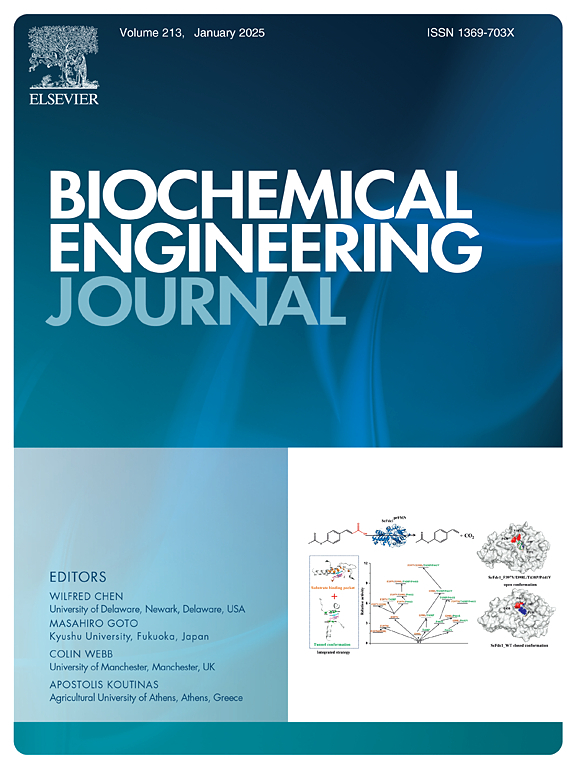Mobius® Breez 灌注微型生物反应器中最大剪切应力的实验测定以及与搅拌罐生物反应器的比较分析
IF 3.7
3区 生物学
Q2 BIOTECHNOLOGY & APPLIED MICROBIOLOGY
引用次数: 0
摘要
灌流工艺近年来越来越受欢迎,因为它能够在生物制药生产中维持较高的细胞密度和生产率,与传统的间歇式和喂料式培养方法相比更具优势。Mobius® Breez 微型生物反应器将传统灌流生物反应器的体积缩小到毫升范围,大大减少了实验工作量,因此是工艺开发的重要工具。然而,微型化在物理环境(如流体动力剪切应力)方面引起了与传统生物反应器可比性的问题。因此,我们对最大流体动力剪切应力、培养性能和膜壁接触进行了评估,以阐明该系统的行为。研究结果显示了两种不同的操作条件,以膜壁接触的有无来区分,从而产生不同程度的流体动力应力。没有膜接触的情况下,应力水平在 CHO 细胞的安全操作阈值范围内,而有膜接触的情况下,应力水平超过了这些阈值,有可能导致细胞损伤。通过确定膜运动的临界频率,这项研究为优化微生物反应器的运行和提高整体生物处理效率提供了启示。本文章由计算机程序翻译,如有差异,请以英文原文为准。
Experimental determination of maximum shear stress in Mobius® Breez perfusion microbioreactors and comparative analysis with stirred tank bioreactors
Perfusion processes have experienced increased popularity in recent years due to their ability to sustain high cell densities and productivities in biopharmaceutical production, offering advantages over traditional batch and fed-batch cultivation methods. The Mobius® Breez microbioreactor significantly reduces experimental effort by downsizing the classical volume of perfusion bioreactors to the mL range and thus represents a valuable tool for process development. However, miniaturization has raised questions regarding comparability with traditional bioreactors in terms of the physical environment, such as hydrodynamic shear stress. Therefore, the maximum hydrodynamic shear stress, cultivation performance, and membrane-wall contact were evaluated to elucidate the system's behavior. Findings reveal two distinct operational conditions, distinguished by the presence or absence of membrane-wall contact, resulting in varying levels of hydrodynamic stress. Conditions lacking membrane contact demonstrate stress levels within safe operating thresholds for CHO cells, while those involving membrane contact exceed these thresholds, potentially leading to cell damage. Through the identification of critical frequencies of membrane motion, this study offers insights for optimizing microbioreactor operation and enhancing overall bioprocess efficiency.
求助全文
通过发布文献求助,成功后即可免费获取论文全文。
去求助
来源期刊

Biochemical Engineering Journal
工程技术-工程:化工
CiteScore
7.10
自引率
5.10%
发文量
380
审稿时长
34 days
期刊介绍:
The Biochemical Engineering Journal aims to promote progress in the crucial chemical engineering aspects of the development of biological processes associated with everything from raw materials preparation to product recovery relevant to industries as diverse as medical/healthcare, industrial biotechnology, and environmental biotechnology.
The Journal welcomes full length original research papers, short communications, and review papers* in the following research fields:
Biocatalysis (enzyme or microbial) and biotransformations, including immobilized biocatalyst preparation and kinetics
Biosensors and Biodevices including biofabrication and novel fuel cell development
Bioseparations including scale-up and protein refolding/renaturation
Environmental Bioengineering including bioconversion, bioremediation, and microbial fuel cells
Bioreactor Systems including characterization, optimization and scale-up
Bioresources and Biorefinery Engineering including biomass conversion, biofuels, bioenergy, and optimization
Industrial Biotechnology including specialty chemicals, platform chemicals and neutraceuticals
Biomaterials and Tissue Engineering including bioartificial organs, cell encapsulation, and controlled release
Cell Culture Engineering (plant, animal or insect cells) including viral vectors, monoclonal antibodies, recombinant proteins, vaccines, and secondary metabolites
Cell Therapies and Stem Cells including pluripotent, mesenchymal and hematopoietic stem cells; immunotherapies; tissue-specific differentiation; and cryopreservation
Metabolic Engineering, Systems and Synthetic Biology including OMICS, bioinformatics, in silico biology, and metabolic flux analysis
Protein Engineering including enzyme engineering and directed evolution.
 求助内容:
求助内容: 应助结果提醒方式:
应助结果提醒方式:


